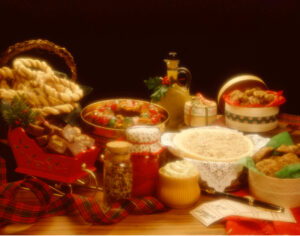Safe Holiday Food Gifts
go.ncsu.edu/readext?835801
en Español / em Português
El inglés es el idioma de control de esta página. En la medida en que haya algún conflicto entre la traducción al inglés y la traducción, el inglés prevalece.
Al hacer clic en el enlace de traducción se activa un servicio de traducción gratuito para convertir la página al español. Al igual que con cualquier traducción por Internet, la conversión no es sensible al contexto y puede que no traduzca el texto en su significado original. NC State Extension no garantiza la exactitud del texto traducido. Por favor, tenga en cuenta que algunas aplicaciones y/o servicios pueden no funcionar como se espera cuando se traducen.
Português
Inglês é o idioma de controle desta página. Na medida que haja algum conflito entre o texto original em Inglês e a tradução, o Inglês prevalece.
Ao clicar no link de tradução, um serviço gratuito de tradução será ativado para converter a página para o Português. Como em qualquer tradução pela internet, a conversão não é sensivel ao contexto e pode não ocorrer a tradução para o significado orginal. O serviço de Extensão da Carolina do Norte (NC State Extension) não garante a exatidão do texto traduzido. Por favor, observe que algumas funções ou serviços podem não funcionar como esperado após a tradução.
English
English is the controlling language of this page. To the extent there is any conflict between the English text and the translation, English controls.
Clicking on the translation link activates a free translation service to convert the page to Spanish. As with any Internet translation, the conversion is not context-sensitive and may not translate the text to its original meaning. NC State Extension does not guarantee the accuracy of the translated text. Please note that some applications and/or services may not function as expected when translated.
Collapse ▲
Many of us are looking for new ideas for gifts this holiday season or we may give gifts of homemade foods already. The Safe Plates Team has some specific advice on making and giving homemade food items so that you are not also giving your friends and family a food-borne illness as well. Some items are less risky than others and can even be gifts young children can help with making. Homemade spice mixes, baking mixes, and breads have very few risks and can be some of the safest to make. Other items create more of a risk, and require extra care when making to prevent higher risks. These are items such as home canned or dried foods, infused items, and some baked goods.
Here are some specific recommendations:
Baked Goods
- Many baked goods, such as breads and cookies, can be stored at room temperature. You want to make sure you keep them covered and note ingredients in case of any food-borne allergies.
- Avoid baking cakes or breads in a jar and sealing them since this is a high risk for illness. More information on the risks from University of New Hampshire .
- Baked goods with cream, custard, cheese, meat and/or vegetable fillings, and cream frostings should be refrigerated to prevent risks for passing on an illness.
Home Preserved Foods
- Follow tested recipes exactly when making canned, pickled, and dehydrate products. Try this reference for tested recipes. National Center for Home Food Preservation
- Preserved items purchased from grocery stores, farmers markets, etc., should not be repackaged.
- Include a note letting people know that once opened the canned food needs to be refrigerated to remain safe to eat.
- If making Jerky, dehydrate meat at 140 degrees in a dehydrator or pre-heated oven if you can keep it at 140 degrees. If using pork or wild game, first freez portions (6 inches thick or less) at 0 degrees for 30 plus days to kill any parasites that may cause illnesses
Infused Foods
- Use glass jars or bottles with tightly sealing lids or corks. Wash in warm soapy water and submerge in boiling water for 10 minutes to sanitize.
- Select high-quality, fresh, or dried herbs, fruits, or vegetables and wash before use.
- Oil: Homemade garlic and/or herb infusions should include pretreating the garlic or herbs with citric acid and then adding to heated oil. Here are some tested recipes that are safe to follow. Making Garlic and Herb Infused Oils
- Vinegars: Herbs and produce for infused vinegar should be properly washed and treated and then added to heated vinegar. Flavored Vinegars
- There are not any researched safe home recipes for infused liquors, or alcohols, so we do not recommend making those as gifts
- To reduce the risk of illness, refrigerate or freeze homemade infused foods until ready to give and share the need to keep refrigerated once given as well.
Dry Spice Mixes and Soups
- Use fresh dried herbs for best flavor.
- Use small food bags or jars.
- Here are some ideas for popular mixes. Spice Mixes
- Some recipes from the North Carolina EFNEP program. Soup and Dried Spice Mixes




